Welche Highlights und Attraktionen dürfen Sie beim Urlaub in Spanien auf keinen Fall versäumen? Hier finden Sie eine Liste der Top 10 Sehenswürdigkeiten von Spanien!
Barcelona, Madrid, Malaga, Sevilla, Bilbao und wie sie alle heißen – die spanischen Städte bieten eine unglaubliche Vielfalt an Sehenswürdigkeiten und Aktivitäten. Geprägt von Jahrtausende alter Geschichte und den Einflüssen verschiedenster Völker lockt das Land zwischen Atlantik und Mittelmeer mit einer atemberaubenden Architektur (einige der schönsten Kirchen und Paläste der Welt stehen in Spanien), interessanten Museen und wertvollen Kulturdenkmälern.
Auch für Bade-Urlaub steht Spanien auf der Liste der beliebtesten Reiseziele Europas ganz weit oben. Abgesehen von den wunderschönen Inseln sind an den Küstenstädten am Mittelmeer oder entlang der Costa del Sol und Costa Brava traumhafte Strände zu finden. Im Hinterland warten abwechslungsreiche Landschaften, vom gebirgigen Baskenland im Norden bis zu den Sanddünen des Doñana Nationalparks im Süden – von der fantastischen Küche und den exzellenten Weinen ganz zu schweigen. Kein Wunder, dass Spanien nach Frankreich das weltweit beliebteste Urlaubsziel ist!
Um Spanien zu entdecken braucht man viel Zeit, denn es gibt eine Menge zu sehen! Und die vielfältigen Inseln, die zu Spanien gehören (die Kanaren, Mallorca, Ibiza, etc.) haben wir dabei noch gar nicht berücksichtigt. Auch wenn es schwerfiel, hier sind unsere Top 10 Sehenswürdigkeiten von Spaniens Festland.
Inhaltsverzeichnis
Sagrada Familia in Barcelona, Spanien
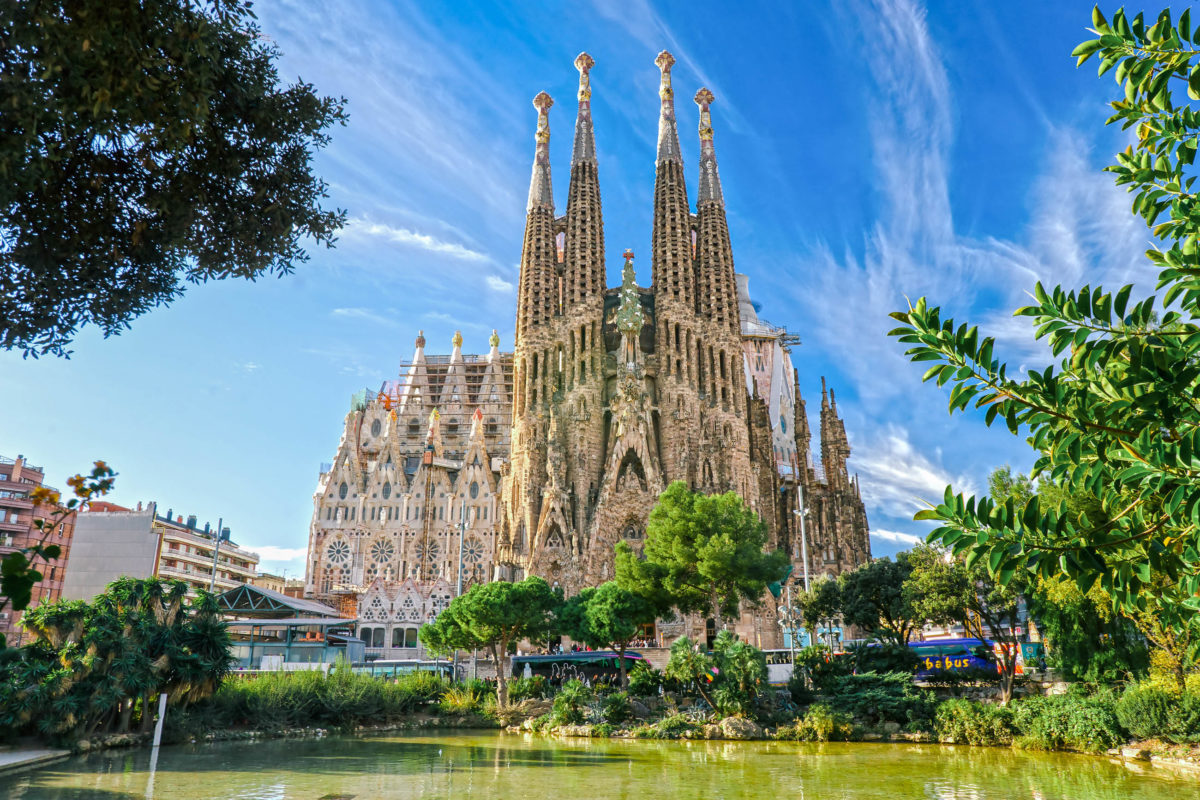
La Sagrada Familia! Diese berühmte Kathedrale ist das wichtigste Aushängeschild der Stadt, zählt zu den Top 10 Sehenswürdigkeiten von Barcelona und gilt für viele als schönste Kirche der Welt. An Antonio Gaudis Meisterwerk wird seit über 100 Jahren gebaut. Dementsprechend kunstvoll und detailreich ist die Architektur, die es hier zu entdecken gilt – der UNESCO war sie einen Eintrag auf der Weltkulturerbeliste wert.
Mit ihren gigantischen Türmen (es gibt nicht weniger als 18 Glockentürme) ist die Sagrada Familia schon weit aus der Ferne zu sehen. Bei ihrer geplanten Fertigstellung 2026 wird sie mit 172 Metern die höchste Kirche der Welt sein.
Betrachtet man die unzähligen Figuren, Buntglasfenster und Reliefs schließlich aus der Nähe, entdeckt man überall symbolhafte Botschaften und biblische Szenen. Gaudi wollte seine Kirche monumentaler und innovativer als jede andere gestalten und mit ihr die Lehren der Kirche erklären. Eine fantastische Vision, die der Realität sehr nahe kommt!
Tipp: Die riesige Kathedrale von Barcelona steht ein wenig im Schatten der weltberühmten Sagrada Familia, ist aber unbedingt auch einen Besuch wert!
Zum Artikel …
Zur Fotogalerie …
Alhambra in Granada

Die Alhambra im Süden Spaniens zählt zu den schönsten und wichtigsten Burgen Europas und ebenfalls zum Weltkulturerbe der UNESCO. Sie liegt auf dem höchsten Hügel von Granada und bietet von ihren Türmen und dem idyllischen mediterranen Garten einen fantastischen Rundumblick.
Die Festung ist über 1000 Jahre alt und wurde schon von den Muslimen als Herrschersitz genutzt. Wo sich heute die Kirche Santa Maria befindet, stand einst eine Moschee. Innerhalb der mächtigen Burgmauern sind außerdem der reich verzierte Renaissancepalast von Kaiser Karl V., die Alcazaba (die mächtige Verteidigungsanlage mit imposanten Wehrtürmen), die eindrucksvollen Nasridenpaläste, das Museum der Schönen Künste und das Museum der Alhambra zu besichtigen.
Tipp: Granada liegt direkt an der sonnenverwöhnten Costa del Sol, die sich mit zahlreichen Ausflugszielen gespickt ideal für einen Bade-Urlaub in Spanien eignet!
Zum Artikel …
Zur Fotogalerie …
Mezquita in Cordoba, Andalusien, Spanien
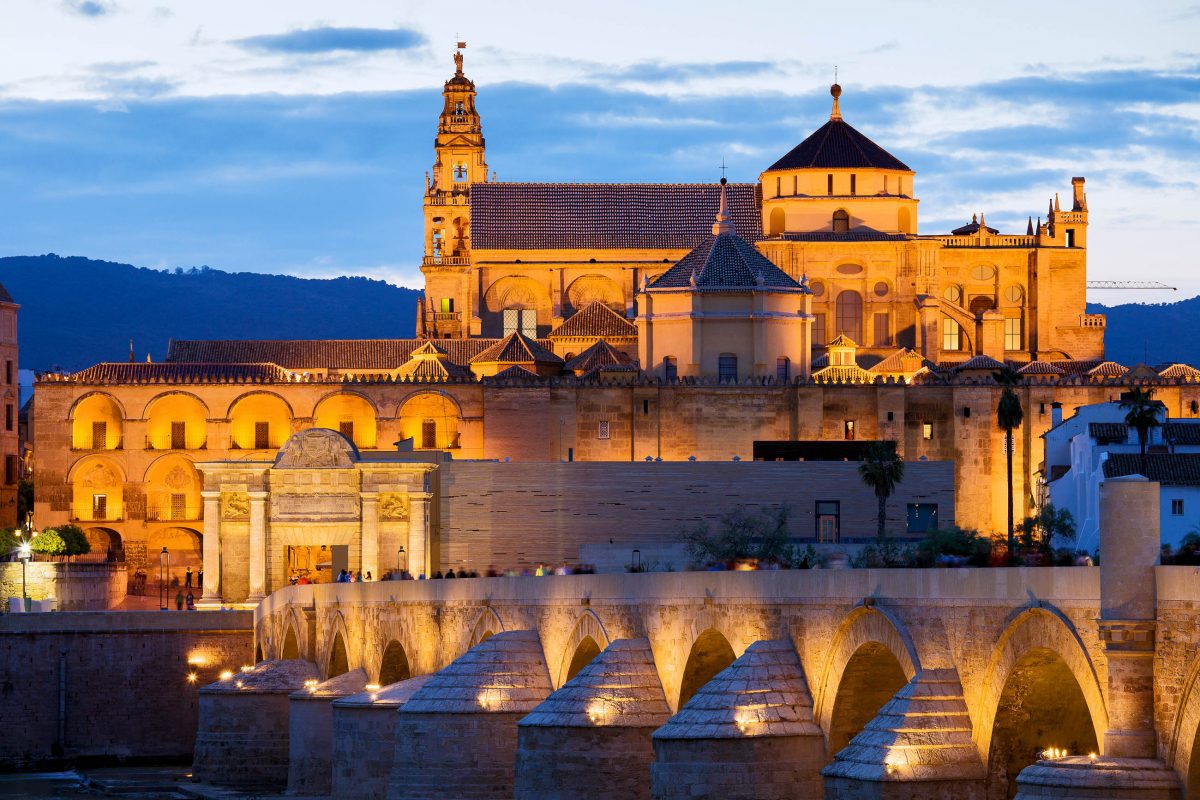
Die Mezquita vereint die Architektur von Süd, Ost und West in einer Form, die das spektakuläre Bauwerk im Herzen von Cordoba weltweit einzigartig macht. Sie zählt zu den größten Moscheen der Welt – und aus ihrer Mitte erhebt sich eine gotische Kathedrale.
Der Ursprung der Mezquita war ein römischer Tempel, danach folgte eine westgotische Kirche, auf dessen Überreste im 8. Jahrhundert eine Moschee entstand, deren Errichtung rund 200 Jahre andauerte.
Zu den Sehenswürdigkeiten der Mezquita zählen neben dem architektonischen Stilmix die kunstvoll verzierte Gebetsnische, der Innenraum mit sage und schreibe 800 Säulen und eine kostbare Monstranz aus dem frühen 16. Jahrhundert.
Palacio Real in Madrid
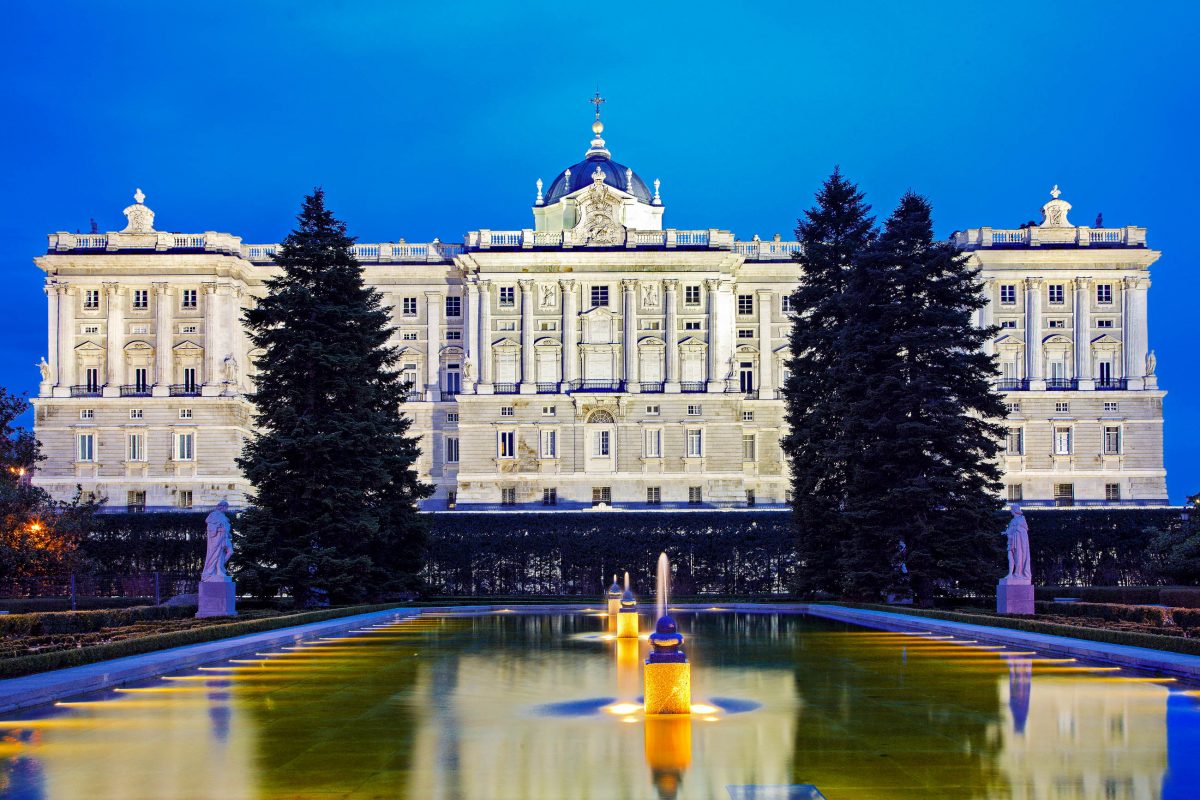
Im Palacio Real in der Hauptstadt Madrid residierte einst die spanische Königsfamilie. Der 500 Meter lange Bau aus weißem Kalkstein und Granit wurde im 18. Jahrhundert eigens als Herrscher-Wohnsitz errichtet. Mittlerweile wohnt die Königsfamilie im Zarzuela-Palast außerhalb von Madrid. Der Palacio Real wird nur noch als Location für kulturelle oder offizielle Anlässe genutzt, ist aber immer noch eine der Top 10 Sehenswürdigkeiten von Madrid.
Der prächtige Bau beherbergt über 3.000 Räume und Säle, von denen einige besichtigt werden können. Zu den öffentlich zugänglichen zählen der Thronsaal, die Spiegelgalerie, der Hellebardensaal und die Schlosskapelle. Außerdem sehenswert sind das Kunstmuseum, die Waffensammlung und die Königliche Apotheke mit Rezepten der Königsfamilien vergangener Zeiten.
Tipp: Abends ist der Eintritt kostenlos (die Warteschlange dafür aber umso länger).
Zum Artikel …
Zur Fotogalerie …
El Escorial in San Lorenzo

Nur etwa 50 Kilometer von Madrid entfernt, in der Stadt San Lorenzo de El Escorial, befindet sich die nächste imposante Königsresidenz, und noch dazu UNESCO-Weltkulturerbe-Stätte. Der imposante Palast El Escorial wurde im 16. Jahrhundert im Auftrag von König Phillip II. errichtet, einerseits um den Sieg über die Franzosen zu feiern, andererseits um seinem Vater Karl V. den Wunsch nach einer eindrucksvollen Grabstätte zu erfüllen.
In dem monumentalen Begräbnispalast mit seiner prachtvollen Basilika (nahezu alle spanischen Könige und Königinnen sind hier begraben) sind innerhalb gewaltiger Mauern auch ein Kloster, eine Schule, eine Bibliothek, ein Architektur- und ein Kunstmuseum zu finden. Letzteres ist vor allem durch den „Schlachtensaal“ berühmt, welcher auf gigantischen Gemälden die wichtigsten Schlachten der Reconquista zeigt.
Zum Artikel …
Zur Fotogalerie …
Kathedrale Santa Maria de la Sede in Sevilla
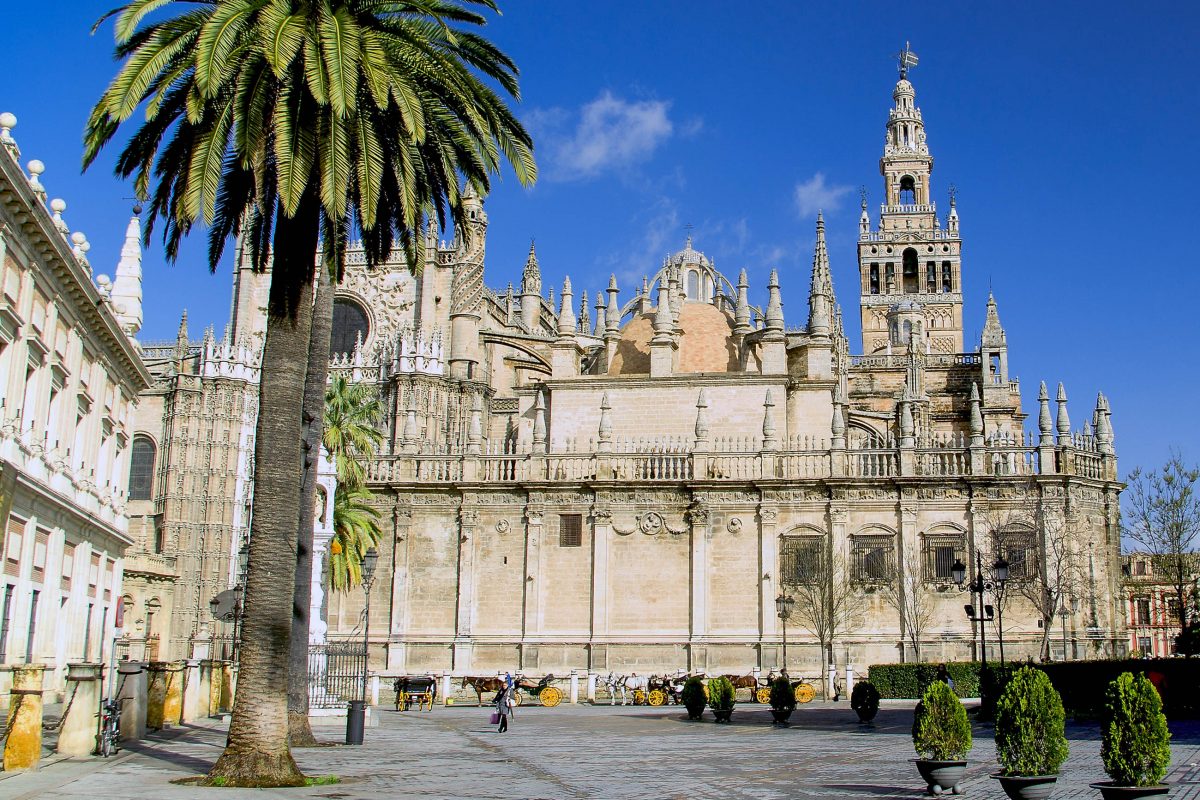
Spanien ist berühmt für seine imposanten Kirchen. Die prächtige Kathedrale Santa Maria de la Sede in Sevilla ist eindeutig eine davon. Sie hält den Titel der größten gotischen Kirche der Welt und ist Teil des UNESCO Weltkulturerbes.
Im Inneren beeindrucken meisterhafte Fresken und Gemälde, spektakuläre Schnitzereien und die mit 23 Metern Höhe größte Altarrentabel der Welt. Auch die letzte Ruhestätte eines weltberühmten Entdeckers und Seefahrers ist hier zu finden. In einem von vier Statuen getragenen Sarg ruht niemand Geringerer als Christoph Kolumbus (oder so heißt es zumindest).
Kurios: Der 100 Meter hohe Glockenturm hat eine muslimische Vergangenheit. Er wurde im 12. Jahrhundert errichtet, als die Mauren über Spanien herrschten – und war damals das Minarett einer prächtigen almohadischen Moschee. Heute kann er bestiegen werden und bietet einen traumhaften Blick über Andalusiens Hauptstadt.
Zum Artikel …
Zur Fotogalerie …
Kathedrale von Toledo
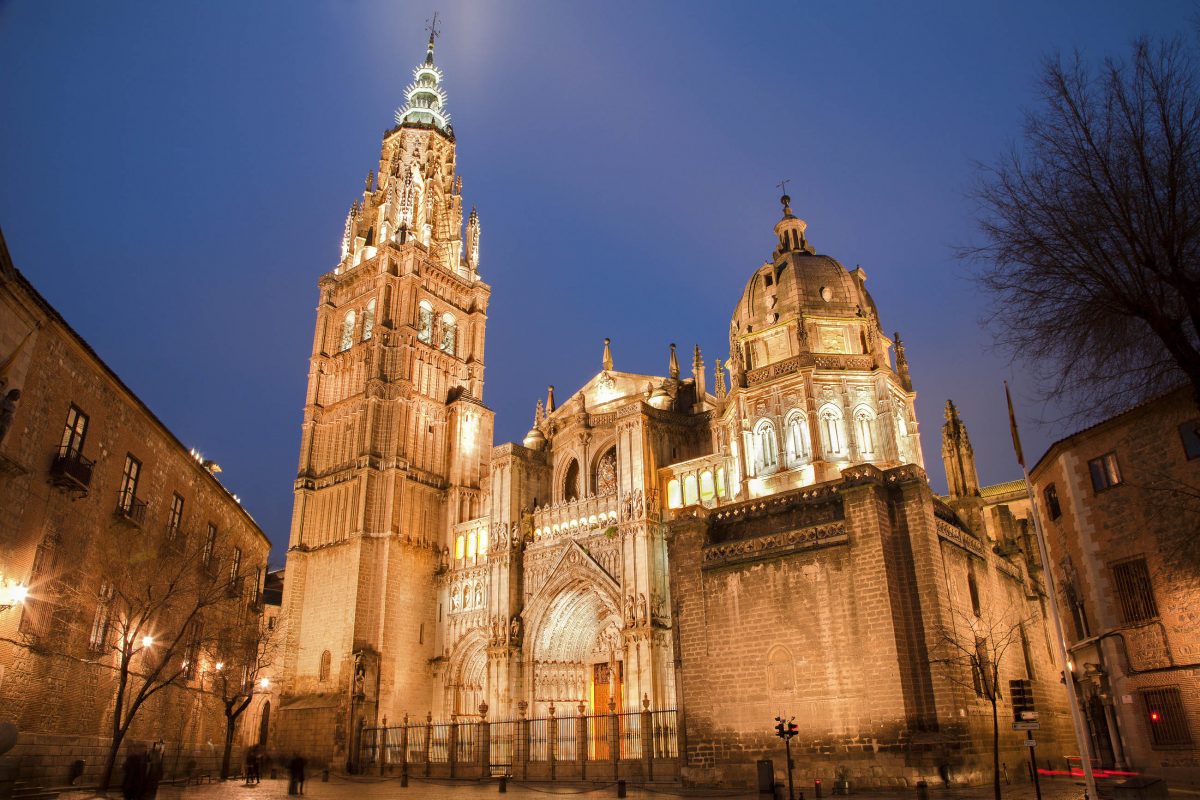
Auch die Kathedrale von Toledo beeindruckt durch ihre schiere Größe und den prachtvollen Dekor ihres Innenraums. Bereits im 6. Jahrhundert stand hier eine Kirche, die unter muslimischer Herrschaft das Schicksal nahezu aller spanischer Kirchen teilte und zur Moschee umfunktioniert wurde.
Nach der Reconquista wuchs ab dem Jahr 1227 eine Kathedrale von immensem künstlerischem und architektonischem Wert in die Höhe. Die pompösen Portale, die über 750 Bleiglasfenster, die kunstvollen Kapellen, der grandios geschmückte Altarraum und eine reich verzierte Schatzkammer lassen keinen Besucher unbeeindruckt.
Tipp: In Toledo startet die Ruta del Don Quijote, die auf den Spuren des berühmten Romanhelden durch La Mancha führt.
Zum Artikel …
Zur Fotogalerie …
Kathedrale von Santiago de Compostela

Neben der Sagrada Familia in Barcelona ist die Kathedrale von Santiago de Compostela die wohl bekannteste Kirche Spaniens. Vor allem den tausenden Pilgern jährlich ist sie wohlbekannt, markiert sie schließlich das langersehnte Ziel einer meist strapaziösen Reise: des Jakobswegs.
Gemeinsam mit der gesamten Altstadt von Santiago de Compostela zählt die Kathedrale zum Weltkulturerbe der UNESCO. Ihre Ursprünge gehen auf das 1. Jahrhundert nach Christus zurück, als in einem heidnischen Mausoleum die Gebeine des Märtyrers und Apostels Jakobus bestattet wurden. Offizieller Baustart ist das Jahr 830. Was damals eine kleine Kirche war, ist heute das wichtigste romanische Bauwerk Spaniens.
Die Atmosphäre in der Kathedrale ist gewaltig! Überall blickt man in erschöpfte, aber glückliche Gesichter. Erleichterung und Stolz über die gemeisterte Pilgerfahrt sind den betenden Menschen deutlich anzusehen. Und inmitten der Kathedrale schwingt der 2m große Botafumeiro in atemberaubendem Tempo bis unter die Decke und verbreitet dringend benötigten Weihrauch-Geruch….
Zum Artikel …
Zur Fotogalerie …
Castillo de Ponferrada in Ponferrada

Wer die Kathedrale von Santiago de Compostela auf dem traditionellen Weg – als Pilger auf dem Jakobsweg – besucht, kommt auch am Castillo de Ponferrada vorbei. Die gewaltige Burg wurde von den Tempelrittern ausgebaut, um die Pilger auf ihrem Weg versorgen und zu beschützen.
Schon die Kelten errichteten an dieser strategisch günstigen Stelle hoch über dem Fluss Sil eine Festung. Auch die Römer nutzten das Bollwerk um die Goldschätze aus Las Médulas zu verteidigen. Ende des 12. Jahrhunderts übernahm der Templerorden auf Geheiß von König Ferdinand II von León.
Rund 200 Jahre später entstanden die 12 monumentalen Türme, die der Festung gemeinsam mit Schießscharten, Zugbrücken, Zinnen und Wehrgängen das Aussehen einer Ritterburg wie aus dem Bilderbuch verleihen – ein wahrlich spektakulärer Anblick!
Zum Artikel …
Zur Fotogalerie …
Nationalpark Ordesa y Monte Perdido, Huesca
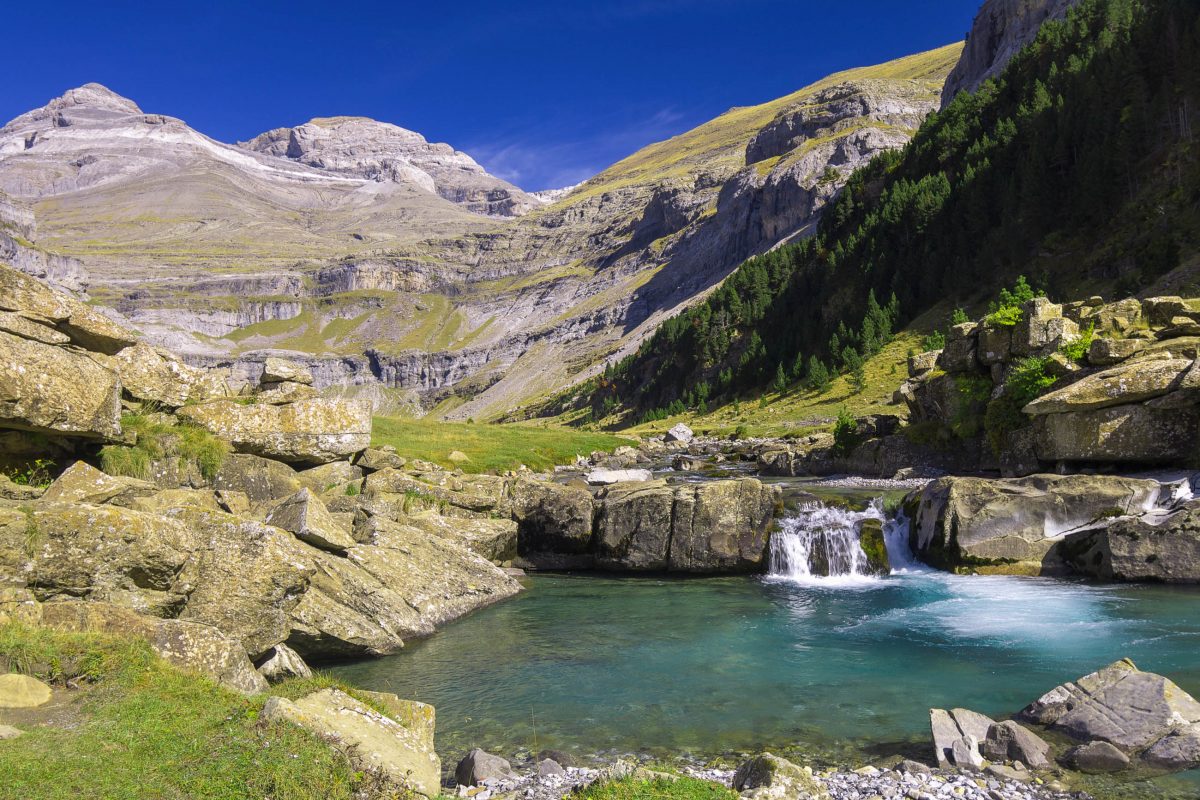
Ein Urlaub in Spanien verspricht auch attraktive landschaftliche Sehenswürdigkeiten und der Nationalpark Ordesa y Monte Perdido ist eindeutig ein Highlight unter ihnen. Er wurde von der UNESCO zum Welterbe erklärt und ist der älteste Nationalpark der Pyrenäen.
Der traumhafte Nationalpark verfügt über vier Eingänge, die alle in unterschiedliche Ökosysteme führen: der Monte Perdido im Norden, das Ordesa-Tal im Westen, die Ansiclo-Schlucht im Süden und das Escuain-Tal im Osten. Besucherzentren informieren über die Sehenswürdigkeiten und besonderen Orte des Ordesa-Nationalparks.
Der gut 15.000 Hektar große Park kann zwar stückchenweise mit dem Auto, am besten aber zu Fuß erkundet werden. Campingplätze sind vorhanden, und auch Dörfer und Bauernhöfe sind innerhalb seiner Grenzen zu finden.




